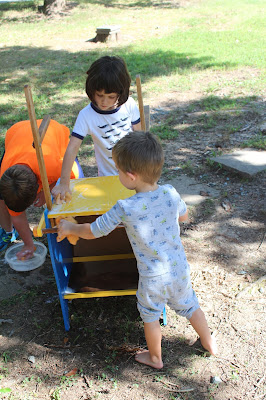At the beginning of September some weird things started happening to Gigi's body - a bloody nose that wouldn't heal, big dark bruises that we couldn't explain, tiny reddish dots on her legs, and finally, sores in her mouth when I went in one night to brush her teeth. And that was when it all came together for me - these symptoms weren't separate from one another, they were all related, and I realized that the inside of her body was bleeding.

After putting the kids to bed, I went straight to the computer and typed out her symptoms in a google search bar. This can be a dangerous idea because being an internet MD has the power to make you certifiably crazy, but I actually found exactly what I needed, immediately. Something called ITP ("Idiopathic Thrombocytopenic Purpura"), or... leukemia. Fortunately, after climbing the mountain of fear, I was able to rule out leukemia because kids with cancer are extremely sick, pale and listless and in contrast, my Gigi was still bouncing off the walls. So, it looked like the culprit was ITP. ITP is an autoimmune disease that occurs when some type of virus goes through the body and offsets the immune system, causing it to identify platelets as enemies and then destroy them. Luckily, the prognosis for kids is fairly good - although it can be dangerous, many kids heal without any intervention and the immune system is able to reset all on its own.

So the following morning I made an appointment at our pediatrician's office, and then I went off to lead the Parent Organization meeting that had been planned weeks before. Marcos took Gigi to the doctor's office and when I arrived, Dr. Goldbach had just finished making his diagnosis - it looked like ITP. I actually was glad that Marcos was there for most of the appointment without me because he's better at stroking the male ego - he just listened patiently to Dr. Goldbach describe the symptoms and then quietly beat him to the punch - "So, you think it looks like ITP....?" Dr. Goldbach laughed and asked, "Have you been doing your research?" Marcos responded, "Metta has". Good man.
After they took Gigi's blood at the pediatric office so that they could look at it under a microscope, we went out for milkshakes as a family and then headed home for a quiet afternoon. Marcos was feeling under the weather himself, and it was relieving to have him home from work for a few days.
A few minutes into my rare afternoon nap, the phone rang and it was Dr. Goldbach. He said that Gigi's platelet count was 5,000 and that we needed to head to the Emergency Room at UNC hospitals, where they would be expecting us. A healthy person has a platelet count of 150,000 to 440,000 and our daughter had 5,000 with sores already in her mouth. Since bleeding in the brain is the worst thing that could happen in this case, and she already had open sores, there was no other option but to take her in immediately to be treated.
After some rather dull hours in the Emergency Room, where I retold our story multiple times at differing levels of detail to every health care provider who came in, we were transported to our room in the Children's Hospital. Gigi's blood had been drawn again in the ER, to confirm her platelet levels, and the result was 8,000 - definitely low enough that she needed treatment. The treatment was called IVIG and it's basically the antibodies of thousands of healthy plasma donors. For whatever reason, it helps to kick the immune system back into normal mode and it will often do the trick permanently, without any need for further treatment or thought about ITP. Gigi was in good spirits in the hospital once we got to the children's floor - there was a play area, access to TV, and there was a pantry full of juice, cereals, Italian Ice and ice cream. Walking around the floor to explore made it very clear that we were in the hospital with a jackpot emergency health crisis - although Gigi needed to be there for treatment, she was literally skipping down the halls, while very sick children lay still in their beds in the rooms we passed along the way. We were really thankful that we weren't there for something worse.
That night we ate sushi for dinner, and Gigi received a very slow drip of the IGIV through an IV in her hand all through the night. Marcos insisted on staying with her so that I could sleep in our comfortable bed, and I went back in the morning after a good night's rest at home. Gigi had slept comfortably all night long, and was in good spirits, although she was mortified by having to pee in the "hat" catch in the toilet, so that the nurses could measure her output. Around noon we were given the okay and were discharged from the hospital. All in all, not a shabby experience. I was slightly frustrated by the seeming lack of communication among the doctors and nurses - they all had different things to say about when we could leave, for example - but when I texted my friend Amber about my frustration, she told me to ask for the Attending Doctor if I wanted clear answers. She spent many years as a nurse and I was grateful for the tip. I hated to "I want to talk to your manager" the place, but when I asked for the Attending to come speak with us, he is the one who really gave us our answers.
The week after Gigi's treatment we went back to the Pediatric Hematology clinic at the Cancer Hospital (again, seeing the other kids there made me very thankful that Gigi was so healthy) and her blood was drawn again to see the treatment had made a lasting change. From a platelet count of 5,000 one week before, she was up to 337,000 - well within the range of normal, and it was such a miracle! I had seen her symptoms clearing over the past week and was hopeful that her platelets were back in action, but the confirmation was so relieving. She was back on track!
So, now what? I have been watching her body in case the platelets improved for a time but not permanently, but we are at the point where we are now in the clear. It is very possible that we will never have to deal with this again. We are thankful for competent health care and for this darling girl Gigi in our lives!


















